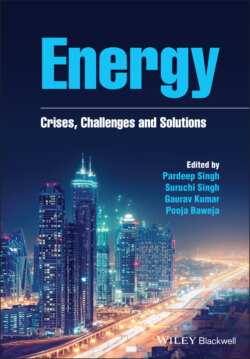Читать книгу Energy - Группа авторов - Страница 12
1.1 Introduction
ОглавлениеThe energy system needs substantial decarbonization to combat climate change (Fawzy et al. 2020). However, climate change itself is often affected by energy system components that include long‐term variations in climate parameters, instability and extreme weather situations (Field et al. 2014). Energy security and climate change are also genuine global issues, which also surface worldwide public policy debates. Significant international attempts to examine climate change policies have been undertaken in the past, in order to make them more conducive to the cause (Helm and Hepburn 2009; Giddens 2011; Held et al. 2011). In this ever‐changing research area, it is vital to review literature that quantifies impacts and evaluates how this information is used to develop energy systems models.
Multiple‐source energy use has always been a primary factor in human survival and civilizational growth. When comparing our ancestors’ energy consumption quantity and trend with modern society, significant changes can be observed. Hunter‐gatherer men’s daily energy needs were about 2500 kcal before the arrival of modern agricultural techniques to sustain their nutrition, storage and reproduction, while modern man’s requirements may exceed more than 100 times their ancestors, depending on their carbon footprint (Dias 2006; WWF 2006). As his key energy source for around 500,000 years, the prehistoric man primarily used food and fire from dry biomass burning. Besides providing heat, light and fuel for cooking, fire became the main defence and cold protection device. Subsequently, people started to spend their resources on land production, and energy use became more complex so that long farming cycles dominated short hunting and gathering times. Hence, a significant advance towards civilization and urban formation was the age of energy that started with fire and firewood and extended into food energy production developments. Both fire and wood were renewable biomass sources during this time.
Moreover, at the beginning of the seventeenth and eighteenth centuries, the invention of steam engines by James Watt allowed the industrial revolution to flourish by using non‐renewable energy resources, especially ‘fossil fuels’, which included natural gas, oil and coal. Fossil fuels have been the key drivers of twenty‐first‐century economic growth from an energy perspective. However, the heavy use of fossil fuels has created some severe environmental issues since the start of the industrial revolution, including global warming, photochemical smog and catastrophic air pollution, many of which are widely documented in the scientific literature.
It is a founded reality that if the greenhouse gas emissions rise is not reversed, events leading to catastrophic changes in the global environment will result in a cascade with a consequential effect on human society and economy. Study efforts to seek alternative and sustainable energy fuels were triggered by a steady increase in energy usage and environmental pollution. Materials and techniques for the efficient use of alternative fuel resources are already being developed by many nations worldwide. These alternative fuels, also known as advanced or non‐traditional fuels, are compounds that can be used as fuels rather than conventional fuels. The word traditional fuel and nuclear materials such as uranium apply to petroleum (oil), coal, propane and natural gas. Biodiesel, bio alcohol (ethanol, methanol), hydrogen, chemically stored electricity (batteries and fuel cells), non‐fossil natural gas, non‐fossil methane and vegetable oils are common alternatives and well known. According to recent research, livestock, forestry and other land activities account for 23% of global human‐origin greenhouse gas emissions. Such emissions are caused by land‐use changes, such as deforestation, allowing space for crops, houses, and factories. Another 44% of the potent greenhouse gas methane comes from human‐driven agriculture, peatland degradation and other land‐based sources (IPCC 2019).
Climate policy security writers have stressed that adequate discursive action has not been taken to counter climate change. There appears to be a broad gap between public policy discourses and their final discourses on climate change and energy security. While less attention has been paid to the relationship between the two major policy areas of climate change and energy protection itself, much attention has been paid to this in recent past. For two reasons, this is a big research field. Since energy accounts for about 60% of global emissions (Baumert et al. 2005), managing energy emissions would be critical for climate reduction goals.
Moreover, in many countries, energy is viewed as a priority policy area, as it is an essential channel for economic development, progress and prosperity. Furthermore, it is relevant not only from a domestic viewpoint, but energy management also functions as a strategic foreign policy (Giddens 2011). Although climate change is bound to affect the energy market, the implications of policies designed to control climate change are expected to be immediate and potentially broader. Climate change issues pervade modern energy policy and resource renewability and energy protection problems that eventually contribute to economic growth. Increasingly strict environmental legislation must be placed on electricity providers to make major investments in lowering pollution, using renewable energy supplies, transmission infrastructure, replacing outdated technology and upgrading the grid.
